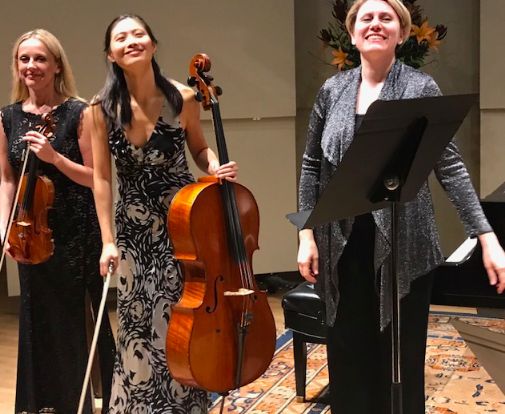|
Symphony
MYSTICAL PLANETS AND LIVELY GERSHWIN ORTIZ AT FINAL SRS CONCERT
by Peter Lert
Sunday, May 4, 2025
Symphony
VSO'S CONCERT MUSIC OF TIME, MUSIC OF PLACE
by Peter Lert
Sunday, April 27, 2025
Choral and Vocal
VOCAL ELEGANCE AND FIRE AT THE 222'S RECITAL APRIL 26
by Pamela Hicks Gailey
Saturday, April 26, 2025
CANTIAMO SONOMA SINGS AN INSPIRED GOOD FRIDAY MOZART REQUIEM CONCERT
by Pamela Hicks Gailey
Friday, April 18, 2025
DRAMATIC SHOSTAKOVICH SYMPHONY CLOSES PHILHARMONIC'S 25TH SEASON
by Terry McNeill
Sunday, April 13, 2025
LARGE COLLEGE OF MARIN AUDIENCE GREETS STOPHER ARTISTRY
by Terry McNeill
Saturday, April 5, 2025
Chamber
FRISSON DELIVERS SHIVERS OF DELIGHT
by Abby Wasserman
Sunday, March 30, 2025
OLD AND MOSTLY NEW IN SRS MARCH CONCERT IN WEILL
by Peter Lert
Saturday, March 22, 2025
Symphony
TWO FORMIDABLE SYMPHONIES AND PURPLE MOUNTAINS AT SRS CONCERT
by Peter Lert
Sunday, February 23, 2025
Chamber
THE PARKER CAPTURES DEMANDING ADES QUARTET AT RAC SEBASTOPOL CONCERT
by Peter Lert
Saturday, February 15, 2025
|
 |
 Manhattan Piano Trio Oct. 13 at Gualala Arts Concert (Judy McNeill photo) |
POTENT MANHATTAN TRIO PERFORMANCES AT GUALALA ARTS CONCERT
by Terry McNeill
Sunday, October 13, 2019
Gualala Arts has been North Coast gem since 1980s, presenting a wide menu of musical programs in the charming small concert hall in the redwoods near the ocean in Gualala, and the Manhattan Piano Trio opened the new season Oct. 13. It was the fifth appearance in Gualala for this New York-based ensemble, with pianist founder pianist Milana Strezeva joined by Trio newcomers Solomiya Ivakhiv (violin) and cellist Sophie Shao.
Haydn’s G Major Trio (Hob. XV/25) opened the concert before an audience of 200 area residents, with Ms. Ivakhiv (standing throughout) leading an interpretation that was direct and often driven in the sprightly opening andante. The hall’s acoustics are almost without reverberation, but the sound is direct and “Papa” Haydn’s compositional charm was everywhere evident. Phrasing in the first two movements was conventional and favored a rich string sound, finishing with a long fermata in the songful adagio.
Things changed in the swirling finale, a rondo with many thematic repeats in a gypsy style (Hungarian? Balkan?) that featured Ms. Strezeva’s driving pianism that although forceful never covered her companion’s sound. It was integrated and balanced playing, jocular but everywhere convincing, and received loud applause.
Schumann’s Five Pieces in Folk Style, Op. 102, followed, spotlighting Ms. Shao’s rich cello virtuosity. Contrasts in the music were emphasized, with perhaps the highlight being the alternating lyrical and then somber effects in the Langsam that resembled a lullaby, with three vivid chords at the end, two of them in arpeggios. Fine instrumental balance continued through the third and fourth movements, the Nicht Schnell slightly strident with several key modulations, and the concluding Stark und Markiert in strict tempo and Ms. Shao’s lovely resonant playing and deft bow control. The hall’s piano is voiced warmly and Ms. Strezeva’s tone color in soft passages was splendid.
The afternoon’s surprise came with Galician composer Anatol Kos-Anatolsky’s Poeme for Violin and Piano, probably in its North Coast premiere. In remarks from the stage Ms. Ivakhiv mentioned that the piece was just recently discovered, though composed long before the composer’s death in 1983. Ms. Strezeva played the pungent introduction with muscular drama, leading into episodic sections that were colorfully tonal and full of high register violin writing and extended pianissimos between phrases.
In the cadenza the violinist favored much tempo fluctuation and potent sforzandos that evolved into a tumultuous folk dance at presto speed, the two instruments often many registers apart but with palpable excitement. The light humorous ending was a surprise.
After a long intermission with gratis refreshments Dvorák’s great Dumky Trio in E Minor, Op. 90, received a committed and convincing reading. The Manhattan seemed to revel in the quirky and complex six-movement piece, with virtuosity everywhere: strong thematic projection, pungent but sporadically dry tone from Ms. Ivakhiv, Ms. Shao’s drone cello line under raucous Czech dance rhythms and lovely unison playing from the two strings. Beginning with the mystery of the first 60 measures, amazing passionate and laconic contrasts unfold in this unique work from 1891, so different from contemporary composers (Brahms, Tchaikovsky, Rubinstein, St. Saëns, Reger, Arensky) that were writing in more established trio formats. The first three movements were played without pause.
Ensemble was solid throughout; even in places were the tempo sharply accelerated or when thematic fragments from each instrument could have blurred the music. They never did. In this work Dvorák can’t let go of expected section endings, and here the Manhattan brought innovative moods and excitement to each extended cadenza and each short violin and piano section, sometimes in tremolo and ostinato. The playing was instrumentally surefooted and artistically distinguished, and at 34 minutes it never seemed at all long.
This elegant and thrilling Dumky performance generated a standing ovation, but no encore was offered.
|

